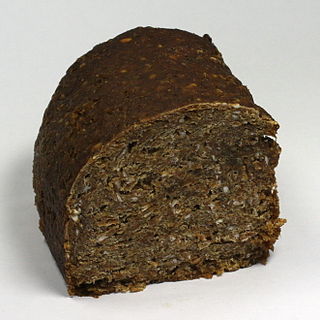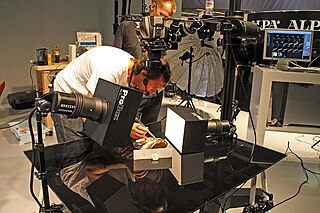 W
WThe 2013 horse meat scandal was a food industry scandal in parts of Europe in which foods advertised as containing beef were found to contain undeclared or improperly declared horse meat – as much as 100% of the meat content in some cases. A smaller number of products also contained other undeclared meats, such as pork. The issue came to light on 15 January 2013, when it was reported that horse DNA had been discovered in frozen beefburgers sold in several Irish and British supermarkets.
 W
WBread has a significance beyond mere nutrition in many cultures in the Western world and Greater Middle East because of its history and contemporary importance. Bread is also significant in Christianity as one of the elements of the Eucharist; see sacramental bread. The word companion comes from Latin com- "with" + panis "bread".
 W
W"Camera eats first" is the behavior and global phenomenon of people taking photos of their meals with digital or smartphone cameras before they eat, mostly followed by uploading the photos to the social media. The term refers to how people "feed" their cameras first by taking photos of their food before feeding themselves. It derives from professional food photography while the behavior of the "Camera Eats First" is generally for personal use such as keeping photographic food diaries instead of commercial purposes. It can also be referred as online food photography, food porn, and photogenic food.
 W
WA chocoholic is a person who craves or compulsively consumes chocolate. The word "chocoholic" was first used in 1968, according to Merriam-Webster. It is a portmanteau of "chocolate" and "alcoholic". The term is used loosely or humorously to describe a person who is inordinately fond of chocolate; however, there is medical evidence to support the existence of actual addiction to chocolate. Psychoactive constituents of chocolate that trigger a ‘feel-good’ reaction for the consumer include tryptophan and phenylethylamine, which may contribute to cravings and addiction-like responses, particularly in people with specific genetic alleles. The quantity of sugar used in chocolate confections also impacts the psychoactive effects of chocolate.
 W
WTo dunk or to dip a biscuit or some other food, usually baked goods, means to submerge it into a drink, especially tea, coffee, or milk. Dunking releases more flavour from confections by dissolving the sugars, while also softening their texture. Dunking can be used to melt chocolate on biscuits to create a richer flavour.
 W
WFood and sexuality have been associated in various ways throughout history. Foods such as chocolate and oysters are said to be aphrodisiacs. In some cultures animal testicles and other items are consumed to increase sexual potency. Food items also provide symbolism, such as the biblical "forbidden fruit" or the cherry with its associations related to virginity. Food items are also used metaphorically in slang sexual terminology and poetry. Some foods are considered sensual for their appearance, texture and taste. Whipped cream, melted chocolate, jam, cake batter, pies, and peanut butter are sometimes used for intimate titillation in an act known as sploshing. The relationship between food and sex has also been explored in books and cinema.
 W
WFood trends are widespread changes in food preferences. Some such trends prove to be long-lasting. Food trends are often discussed in magazines devoted to cuisine, and around the internet.
 W
WFoodgasm is a neologism that indicates a pleasurable and euphoric feeling of satisfaction that occurs during the consumption of particularly amazing and delicious foods: this pleasure is sometimes accompanied by vocal noises and a variety of facial expressions.
 W
WGastronomy is the study of the relationship between food and culture, the art of preparing and serving rich or delicate and appetizing food, the cooking styles of particular regions, and the science of good eating. One who is well versed in gastronomy is called a gastronome, while a gastronomist is one who unites theory and practice in the study of gastronomy. Practical gastronomy is associated with the practice and study of the preparation, production, and service of the various foods and beverages, from countries around the world. Theoretical gastronomy supports practical gastronomy. It is related with a system and process approach, focused on recipes, techniques and cookery books. Food gastronomy is connected with food and beverages and their genesis. Technical gastronomy underpins practical gastronomy, introducing a rigorous approach to evaluation of gastronomic topics.
 W
WA grace is a short prayer or thankful phrase said before or after eating. The term most commonly refers to Christian traditions. Some traditions hold that grace and thanksgiving imparts a blessing which sanctifies the meal. In English, reciting such a prayer is sometimes referred to as "saying grace". The term comes from the Ecclesiastical Latin phrase gratiarum actio, "act of thanks." Theologically, the act of saying grace is derived from the Bible, in which Jesus and Saint Paul pray before meals. The practice reflects the belief that humans should thank God who is the origin of everything.
 W
WHangover remedies consist of foods, dishes, and medicines, that have been described as having a theoretical potential for easing or alleviating symptoms associated with the hangover.
 W
WThe Philosophy of Eating is a book on nutrition by American homeopathic physician Albert J. Bellows (1804-1869). The book was first published in 1867 with the posthumous edition descriptor line Late Professor of Chemistry, Physiology, and Hygiene, and reprinted in later years to the current Philosophy of Eating. Entered, according to Act of Congress, in the year 1867, by Bellows, in the Clerk's Office of the District Court of the District Massachusetts stereotyped at the Boston Stereotype Foundry.
 W
WFood photography is a still life photography genre used to create attractive still life photographs of food. It is a specialization of commercial photography, the products of which are used in advertisements, magazines, packaging, menus or cookbooks. Professional food photography is a collaborative effort, usually involving an art director, a photographer, a food stylist, a prop stylist and their assistants.
 W
WSylheti cuisine represents the food culture of Sylhetis. It comprises tangy sour Hatkora to spicy hot chicken tikka masala or Hatkora beef, confectionery Tusha Shinni to savoury Nunor Bora and the fermented fish Hutki Shira. Hatkora is a common fruit and used to cook different dishes with fish and meat. Enriched with Vitamin C and antioxidants, Hatkora curry is best eaten with rice. Though Sylhetis are mainly rice and fish eaters, their culinary system is distinctly different to non-Sylhetis. Multicultural people of Barak Valley to Surma valley, and the Sylheti diaspora have influenced the Sylheti food and flavours practiced for ages. Among them, the culinary system of Khasi, Kuki and other tribes are noteworthy. The cuisine of Sylhet has grown up depending on the availability of plants and animals in the region. Mainly indigenous with some variety, food culture is performed among the Sylhetis that received some external influences as well. When the 360 disciples of Shah Jalal arrived in this region, they not only brought their distinct cultures but also brought distinct cooking styles of their own. Which included many meat dishes along with chicken, beef and goat cooked Mughlai, Middle-Eastern, and Northern Indian style. Mughlai Porota, Pilau, Korma, Kalia, Roast, Biriyani and Kofta for curry dishes while Zardah, Firni and Kheer for desserts have been also included.
 W
WThree Great Noodles of Morioka is a term to describe the noodle dishes morioka reimen, morioka Jajamen, and wanko soba of the city of Morioka, Iwate Prefecture, Japan.Morioka Reimen is a cold noodle dish based on Korean naengmyeon. Morioka Jajamen is a dish with meat miso on thin udon noodles, based on Chinese zhajiangmian. Wanko soba is a style of Japanese soba, served in many small bite-sized bowls.